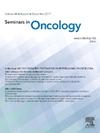综合分析scRNA-seq和大量RNA-seq数据,确定BHLHE40是胰腺癌进展和吉西他滨耐药的关键基因
IF 2.5
3区 医学
Q2 ONCOLOGY
引用次数: 0
摘要
目的胰腺癌具有死亡率高、生存期短的特点,迫切需要新的治疗靶点和个性化治疗策略。在这项研究中,我们的目的是研究胰腺导管腺癌(PDAC)进展和化疗耐药的分子机制,重点是寻找新的治疗靶点。方法采用多组学方法鉴定PDAC新的可操作靶点。利用TCGA和GEO等公共数据集来研究基因表达与临床结果的关系。功能富集、细胞间通讯和代谢途径分析揭示了PDAC的异质性和治疗耐药机制。结果bhlhe40被鉴定为高cnv PDAC细胞、吉西他滨耐药和PDAC不良预后相关的枢纽基因。BHLHE40高表达与免疫抑制肿瘤微环境(TME)特征显著相关,如CD8+ T浸润减少、TCR丰富度降低、肿瘤突变负担(TMB)降低。ChIP-seq数据分析证实BHLHE40可以直接结合SAT1启动子,建立一个促进化学耐药的转录轴。单细胞RNA-seq分析进一步显示BHLHE40+/SAT1+亚群细胞在PDAC中对吉西他滨耐药。结论shbhlhe40通过SAT1调控和免疫逃逸与PDAC恶性肿瘤及化疗耐药相关。靶向BHLHE40可能使PDAC对吉西他滨敏感,促进BHLHE40+ PDAC患者的个性化治疗。本文章由计算机程序翻译,如有差异,请以英文原文为准。
Integrated analysis of scRNA-seq and bulk RNA-seq data identifies BHLHE40 as a key gene in pancreatic cancer progression and gemcitabine resistance
Objective
Pancreatic cancer is characterized by its high mortality rate and short survival periods, and novel therapeutic targets and tailor personalized strategies are urgently needed. In this study, we aim to investigate the molecular mechanisms underlying pancreatic ductal adenocarcinoma (PDAC) progression and chemoresistance, with a focus on identifying novel therapeutic targets.
Methods
Multiomics approaches were integrated to identify novel actionable targets for PDAC. Public datasets such as TCGA and GEO were utilized to investigate the relationship between gene expression and clinical outcomes. Functional enrichment, cell-cell communication, and metabolic pathway analyses were performed to reveal PDAC heterogeneity and therapeutic resistance mechanisms.
Results
BHLHE40 was identified as a hub gene linked to high-CNV PDAC cells, Gemcitabine resistance, and poor prognosis in PDAC. High BHLHE40 expression is significantly correlated with immunosuppressive tumor microenvironment (TME) features such as reduced CD8+ T infiltration, TCR richness, and lower tumor mutational burden (TMB). ChIP-seq data analysis confirmed BHLHE40 could directly bind to the SAT1 promoter, establishing a transcriptional axis promoting chemoresistance. Single-cell RNA-seq analysis further revealed that the BHLHE40+/SAT1+ subpopulation cells are resistant to Gemcitabine in PDAC.
Conclusions
BHLHE40 is significantly correlated with PDAC malignancy and chemoresistance via SAT1 regulation and immune evasion. Targeting BHLHE40 may sensitize PDACs to Gemcitabine and facilitate personalized treatment for BHLHE40+ PDAC patients.
求助全文
通过发布文献求助,成功后即可免费获取论文全文。
去求助
来源期刊

Seminars in oncology
医学-肿瘤学
CiteScore
6.60
自引率
0.00%
发文量
58
审稿时长
104 days
期刊介绍:
Seminars in Oncology brings you current, authoritative, and practical reviews of developments in the etiology, diagnosis and management of cancer. Each issue examines topics of clinical importance, with an emphasis on providing both the basic knowledge needed to better understand a topic as well as evidence-based opinions from leaders in the field. Seminars in Oncology also seeks to be a venue for sharing a diversity of opinions including those that might be considered "outside the box". We welcome a healthy and respectful exchange of opinions and urge you to approach us with your insights as well as suggestions of topics that you deem worthy of coverage. By helping the reader understand the basic biology and the therapy of cancer as they learn the nuances from experts, all in a journal that encourages the exchange of ideas we aim to help move the treatment of cancer forward.
 求助内容:
求助内容: 应助结果提醒方式:
应助结果提醒方式:


